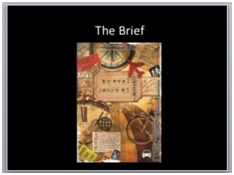A Coaching Model Created by Hillik Nissani
(Executive Coach, CYPRUS)
Why “Travel”?
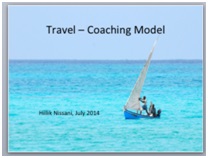 Many people refer to life as a “Journey”. We also mention the term “Path” when we talk about a Career.
Many people refer to life as a “Journey”. We also mention the term “Path” when we talk about a Career.
In my model, I use an analogy of taking a trip from point A to point B, which I find is similar to a client trying to get from his ‘current state’ to a new, desired ‘improved sate’.
Similar to a trip, the clients’ process involved self-discovery (a brief), decision on goals (destination), some planning, commitment (making actual reservations for flights, hotels, etc.), preparing a set of tools to use (packing according to the destinations) and once the process starts, some guides on how to correct course, optimise and reach the goals (the travelling itself).
Once the clients have reached their destination, it is important to celebrate it, acknowledge the effort and reward themselves for their achievements.
Lastly, It is important to check what has worked well during the process and what could have done differently or better. Such learning is designed in order to improve the efficiency, affectivity and enjoyment of the next trip.
This is the Debrief.
The Structure
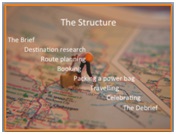 The Brief
The Brief- Destination research
- Route planning
- Booking
- Packing a power bag
- Travelling
- Celebrating
- The Debrief
The Brief
- Get to know the client and connect, gain their trust.
- Discovery
- Map their beliefs and values
- Use the “wheel of life” tool to understand their current ‘status’ in the various life dimensions
- Learn from them about any other relevant background or info they want to share with us
- Understand their learning style
- Understand their interests, challenges and reasons to embark on the journey.
- Inspire & motivate them.
Destination Research
This stage is about gathering facts and deciding on the goal/s. This is the decision on where the clients want to go to – their destinations.
- The clients know best what they want, but a reality check is needed. Not all destinations are easy to reach or worthwhile reaching, so goals have to be SMART. This is the coach’s role to help them set the right destinations for them.
- This process involves
- Understanding their subconscious decision-making – by investigating and highlighting limiting and empowering beliefs, vicious circles, etc.
- Guiding them how to switch from being ‘unconscious’ to becoming ‘consciously competent
Route Planning
 Clients now know where they are going. They need to create a plan as to how to get there.
Clients now know where they are going. They need to create a plan as to how to get there.
- Break the long trip into smaller parts
- Take existing resources into account
- Learn how to acquire additional resources
- Learn to ask for, and receive help
- Consider timelines
- List of possible constraints
- List possible issues and hurdles that may arise and how to handle them
Booking
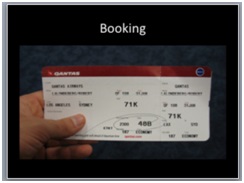 The booking phase is the actual commitment to the process/trip. Absent that, no trip will ever commence or get the clients to their desired destinations.
The booking phase is the actual commitment to the process/trip. Absent that, no trip will ever commence or get the clients to their desired destinations.
Since commitment is easy to state, but harder to consistently demonstrate, supporting structures and power tools should be used. We, as coaches, shall guide the clients in listing a few of their existing tools and structures as well as in learning how to acquire, test and use more such tools – to help them stay focused, in action and committed to reaching their destinations.
Packing a “Power Bag”
 No trip is ever embarked without the necessary packing. In this stage, we make sure the clients have the right set of Power Tools they can use along their route, Power Tools that will make their trip successful, enjoyable and help them mitigate and handle any issues or hurdles that may arise.
No trip is ever embarked without the necessary packing. In this stage, we make sure the clients have the right set of Power Tools they can use along their route, Power Tools that will make their trip successful, enjoyable and help them mitigate and handle any issues or hurdles that may arise.
This is not about us dictating a set of Power Tools, but rather about focusing on making sure they already possess some, guiding them on how to acquire and how to pack and collect such tools and how to properly use them (i.e. test what works for them and decide what to keep or replace).
Travelling
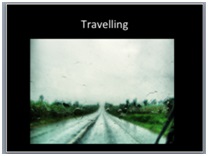 The clients are now “in process”. They are executing their plans and going through a mix of successes and gains versus challenges and hurdles along the planned route. This is where the “Power Bag” comes handy. The Coach shall guide the clients on using the Power Tools and support structures, and handle any other issue that might rise. In a sense, the Coach is one of the Supporting Structures the client is using. The Coach is the “tour guide”.
The clients are now “in process”. They are executing their plans and going through a mix of successes and gains versus challenges and hurdles along the planned route. This is where the “Power Bag” comes handy. The Coach shall guide the clients on using the Power Tools and support structures, and handle any other issue that might rise. In a sense, the Coach is one of the Supporting Structures the client is using. The Coach is the “tour guide”.
Some clients will go directly from point A to B, while others may explore other routes along the process (or trip) as they make progress. Such exploration is a potential opportunity for personal growth, for the expansion of the clients comfort zone, and a great way to expand their skills-set and mental strength.
Along the way, possible drawbacks may occur and the traveller, or the client, will have to deal with them, using the Power Tools in his Power Tool Bag, or by investigating and acquiring new Power Tools (and adding them to his Power Tool Bag).
Every part of the trip can be looked at as a whole trip and treated as such – setting a smaller goal, preparing for it, planning the route and making the trip, thus creating a “trip within a trip”.
Celebrating
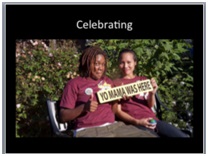 Reaching the destination or achieving the goal is a reason to celebrate. It is the clients’ opportunity to acknowledge their efforts, learning, development and achievements.
Reaching the destination or achieving the goal is a reason to celebrate. It is the clients’ opportunity to acknowledge their efforts, learning, development and achievements.
It is a good opportunity for the clients to reward themselves.
The Celebration is a great way to create the necessary positive emotions and feelings that will contribute to the creation of new beliefs and for gaining confidence in their abilities to reach even higher goals. This process will then gradually replace the old limiting beliefs with new empowering beliefs and break old vicious circles.
The Debrief
 No process is complete without a proper debriefing.
No process is complete without a proper debriefing.
Originally used by soldiers and pilots, this stage of investigation analyses:
- What happened?
- What did we do well and want to keep doing?
- What did we not do well and need to stop doing or start doing in a different, better way?
The Debrief is one of the best tools to capitalize on the experiences and create numerous learning moments. It is the time for the client to look into its Power Bag and assess it – what has to be kept, modified, replaced or what is missing.
It is the client’s moment of truth, the outcome of which is pure growth.
Debriefs can be used for both the “grand trip” as well as for the sub-trips along the trip.
Image credits by order
- https://flic.kr/p/4FQLNZ
- https://flic.kr/p/aUeCLk
- https://flic.kr/p/9XwYzp
- https://flic.kr/p/68UbfV
- https://flic.kr/p/v9xmK
- https://flic.kr/p/9vcoV
- https://flic.kr/p/4o1Rn4
- https://flic.kr/p/aTHS8M
- https://flic.kr/p/7u8skp
- https://flic.kr/p/aSfvHT
